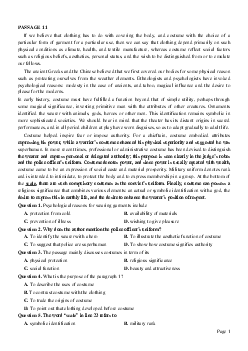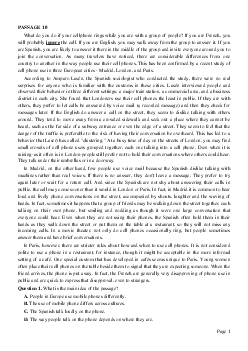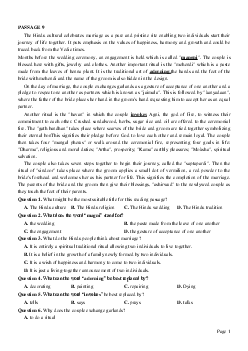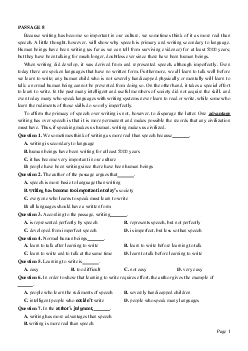


Preview text:
PASSAGE 1
THE MODERN CARS OF THE FUTURE
Today's car are smaller, safer, cleaner, and more economical than their predecessors, but the car of the
future will be far more pollution-free than those on the road today. Several new types of automobile
engines have already been developed that run on alternative sources of power, such as electricity,
compressed natural gas, methanol, steam, hydrogen, propane. Electricity, however, is the only zero-
emission option presently available.
Although electric vehicles will not be truly practical until a powerful, compact battery or another
dependable source of current is available, transportation expects foresee a new assortment of electric
vehicles entering everyday life: shorter-range commuter electric cars, three-wheeled neighborhood cars,
electric delivery vans, bikes, and trolleys.
As automakers work to develop practical electric vehicles, urban planners and utility engineers are
focusing on infrastructure systems to support and make the best use of the new cars. Public charging
facilities will need to be as common as today's gas stations. Public parking spots on the street or in
commercial lots will need to be equipped with devices that allow drivers to charge their batteries while
they stop, dine, or attend a concert. To encourage the use of electric vehicles, the most convenient parking
in transportation centers might be reserved for electric cars.
Planners foresee electric shuttle buses, trains, and neighborhood vehicles all meeting at transit centers that
would have facilities for charging and renting. Commuters will be able to rent a variety of electric cars to
suit their needs: light trucks, one-person three-wheelers, small cars, or electric/ gasoline hybrid cars for
longer trips, which will no doubt take place on automated freeways capable of handling five times the
number of vehicles that can be carried by a freeway today.
Question 1. The following electric vehicles are all mentioned in the passage EXCEPT: A. trolleys B. trains C. vans D. planes
Question 2. The author's purpose in the passage is to
A. criticize conventional vehicles
B. describe the possibilities for transportation in the future
C. narrate a story about alternative energy vehicles
D. support the invention of electric cars
Question 3. The passage would most likely be followed by details about
A. the neighborhood of the future
B. pollution restrictions in the future C. automated freeways
D. electric shuttle buses
Question 4. The word "compact" in the second paragraph is closest in meaning to A. long-range B. concentrated C. inexpensive D. squared
Question 5. In the second paragraph the author implies that
A. everyday life will stay such the same in the future.
B. a dependable source of electric energy will eventually be developed.
C. a single electric vehicle will eventually replace several modern of transportation.
D. electric vehicles are not practical for the future.
Question 6. According to the passage, public parking lots of the future will be Page 1
A. more convenient than they are today
B. as common as today's gas stations
C. much large than they are today
D. equipped with charging devices
Question 7. The word "charging" in this passage refer to A. parking B. credit cards C. electricity D. lightening
Question 8. It can be inferred from the passage that
A. the present cars are more economical than their future generation
B. electricity is the best alternative source of power as it is almost free of pollution
C. the present electric engines are the best option as being practical
D. many new types of practical electric engines have been developed
Question 9. he word "hybrid" in paragraph 4 is closest in meaning to A. automated B. hazardous C. futuristic D. combination
Question 10. The word "commuters" in paragraph 4 refer to A. cab drivers B. visitors C. daily travelers D. shoppers ĐÁP ÁN 1-D 2-B 3-C 4-B 5-B 6-D 7-C 8-B 9-D 10-C
LỜI GIẢI CHI TIẾT Question 1: D planes = máy bay Question 2: B
describe the possibilities for transportation in the future = mô tả khả năng về giao thông trong tương lai Question 3: C
automated freeways = các con đường được tự động hóa Question 4: B
concentrated = được tập trung Question 5: B
a dependable source of electric energy will eventually be developed
Thông tin ở đoạn sau: “Although electric … and trolleys.” (Dù các xe bằng điện sẽ không thực sự thiết
thực cho đến khi các pin khỏe và rắn chắc hoặc một nguồn năng lượng đáng tin cậy nào đó đi vào cuộc
sống thường ngày: ô tô điện ngắn hạn, các ô tô ba bánh, xe tải chở hàng bằng điện, xe đạp và xe đẩy tay.) Question 6: D
equipped with charging devices
Thông tin ở đoạn sau:”Public parking spots … a concert” (Các khu vực để xe công cộng trên đường hoặc
ở các khu thương mại sẽ cần phải được trang bị các thiết bị mà cho phép người lái xe sạc pin của họ
trongkhi họ dừng lại, dùng bữa hoặc tham gia một buổi nhạc hội.) Question 7: C electricity = nạp điện Page 2 Question 8: B
electricity is the best alternative source of power as it is almost free of pollution = điện là nguồn năng
lượng thay thế tốt nhất vì nó hầu như không gây ô nhiễm.) Question 9: D
combination = sự phối hợp Question 10: C
daily travelers = người đi lại hàng ngày Page 3




